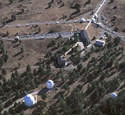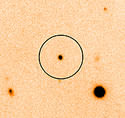
Image credit: NASA
It was a bit of a rough ride, but Pathfinder arrived on the surface of Mars back in 1997 in perfect condition. It was the innovative (and unproven) airbag system that helped slow the lander’s descent, so NASA is planning to employ the system again for the 2003 Mars Exploration Rover missions. These rovers have a different mass than Pathfinder, so NASA engineers have gone back to the drawing board to figure out how to make airbags that inflate seconds before touchdown and can withstand an impact at freeway speeds.
Just one of the many problems in landing on another planet, after it’s been determined where to land and the method to get there, is landing safely. For JPL, a safe landing is “the name of the game,” as engineers work to prepare two rovers for the journey to Mars.
The Mars Exploration Rovers scheduled for launch in 2003 are using the same type airbag landing system that Mars Pathfinder used in 1997. The airbags must be strong enough to cushion the spacecraft if it lands on rocks or rough terrain and allow it to bounce across Mars’ surface at freeway speeds after landing. To add to the complexity, the airbags must be inflated seconds before touchdown and deflated once safely on the ground.
“The 2003 rovers have a different mass [than Sojourner, the Pathfinder rover], so we’ve made changes in the airbag design,” said John Carson, cognizant engineer. “Our requirement is to be able to land safely on a rock extending about a half-meter (about 18 inches) above the surface. Extensive testing gives us a process for trial and error before the final design.”
How to Build a Better Airbag
While most new automobiles now come with airbags, spacecraft don’t. The fabric being used for the new Mars airbags is a synthetic material called Vectran that was also used on Mars Pathfinder. Vectran has almost twice the strength of other synthetic materials, such as Kevlar, and performs better at cold temperatures.
Denier is a term that measures the diameter of the thread used in the product. There will be six 100-denier layers of the light but tough Vectran protecting one or two inner bladders of the same material in 200-denier, according to Dara Sabahi, mechanical systems architect. Using the 100-denier means there is more actual fabric in the outer layers where it is needed, because there are more threads in the weave.
Each rover uses four airbags with six lobes each, which are all connected. Connection is important, since it helps abate some of the landing forces by keeping the bag system flexible and responsive to ground pressure. The fabric of the airbags is not attached directly to the rover; ropes that crisscross the bags hold the fabric to the rover. The ropes give the bags shape, which makes inflation easier. While in flight, the bags are stowed along with three gas generators that are used for inflation.
Testing, Testing, Testing
Since the airbags are composed of many layers, some tearing in the outer layers is acceptable and even expected. Engineers test the bags to make sure there will be no catastrophic problems that would prevent a safe landing.
Mars airbag testing is done in world’s largest vacuum chamber at the Plum Brook Station of NASA’s Glenn Research Center in Ohio. “The Plum Brook facility is pretty impressive, along with all the people who operate it,” said Carson.
The test chamber used for the tests is a little over 30 meters (100 feet) across and about 37 meters (120 feet) high — big enough that three railroad tracks go through it. A test spacecraft and airbag system weighing about 535 kilograms (about 1,180 pounds) are accelerated with a bungee cord system onto a platform with rocks that approximate the Mars surface. The drop is at landing speed, about 20 to 24 meters (yards) per second.
Tests are documented thoroughly with high-speed and video cameras, in addition to visual inspections. Engineers even built a clear dome, studded with rocks, that has a camera that documents tests from a rock’s-eye view. During testing, a crew from ILC Dover, the airbag’s manufacturer, stands by to make quick repairs and to note any changes required.
“We do extensive testing,” said Tom Rivellini, deputy mechanical systems architect. “We want to break the bag on Earth, not on Mars. If we see a tear that is unexpected or goes too deep, we can make changes now [before the final design].”
Carson added, “We’ll go over all the data we’ve accumulated so far, do some more testing, and decide on a design configuration.”
And then on to Mars in 2003!



